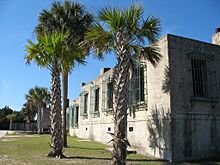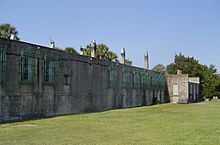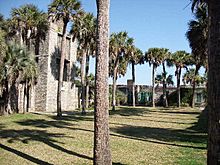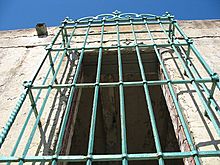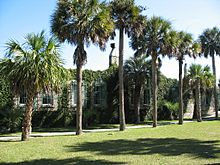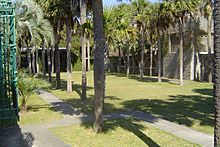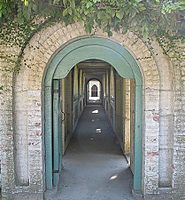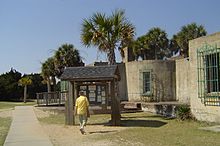Atalaya Castle (US) facts for kids
|
Atalaya
|
|
|
U.S. National Historic Landmark District
Contributing Property |
|

Ocean side view of the 'Atalaya Castle' facade.
|
|
| Nearest city | Murrells Inlet, South Carolina |
|---|---|
| Built | 1931 |
| Architect | Archer Milton Huntington; William Thompson |
| Part of | Atalaya and Brookgreen Gardens (ID84002045) |
| NRHP reference No. | 84002045 |
Quick facts for kids Significant dates |
|
| Added to NRHP | September 7, 1984 |
| Designated NHLDCP | October 5, 1992 |
Atalaya Castle, also called Atalaya, was a special winter home. It belonged to a wealthy businessman named Archer M. Huntington and his wife, Anna Hyatt Huntington, who was a famous sculptor. This unique house is found in Huntington Beach State Park near the Atlantic Ocean in Murrells Inlet, South Carolina.
Archer Huntington loved Spanish culture and art. He designed Atalaya to look like old buildings from the Spanish coast. It has styles called Moorish Revival and Mediterranean Revival architecture.
Contents
Building Atalaya: A Winter Home
Atalaya was built right by the Atlantic Ocean in South Carolina. The Huntingtons chose this spot because the weather was milder in winter. This was important for Anna Huntington's health, as she had tuberculosis during the 1920s and 1930s.
The large stone building is about 200 feet by 200 feet. It was built between 1931 and 1933. Archer Huntington designed the whole house in his mind, without needing detailed drawings! He made sure that local people were hired to build it. This helped many families who were struggling during the Great Depression.
What Does Atalaya Look Like?
The name Atalaya (say: ah-tuh-LIE-yuh) means "watchtower" in Spanish. This name fits because the house has a tall, square tower. This tower held a huge water tank that could hold 3,000 gallons of water. The tower stands almost 40 feet tall and splits the main courtyard of the house.
The inner walls of the courtyard were covered with climbing fig vines. You could also see Sabal palmettos, which are the state tree of South Carolina, and other types of palm trees.
The living areas of the house have 30 rooms. These rooms are built around three sides of the building. Anna Huntington's art studio was also part of the house. It had a 25-foot-tall skylight to let in lots of light. Her studio opened onto a small, private courtyard. Here, she worked on her sculptures.
Next to her open studio, there were special pens for animal models. Anna used real animals like horses, dogs, and even bears to help her create her sculptures. The house also has beautiful iron grills on the windows. Anna Huntington designed these herself. These grills and strong shutters helped protect the house from hurricane winds.
Atalaya's Later Years
During World War II, the Huntingtons left Atalaya. They allowed the Army Air Corps to use the house from 1942 to 1946.
The Huntingtons used Atalaya as their winter home for the last time in 1947. After Archer Huntington passed away in 1955, most of the furniture was sent to New York City. Anna's studio equipment was moved to a new studio at Brookgreen Gardens. This garden is just across U.S. Route 17, which now goes through what used to be the Huntingtons' large property.
Atalaya Becomes a Public Park
In 1960, the Huntingtons' land, which was about 2,500 acres, was leased to the state of South Carolina. It became a state park for everyone to enjoy. Anna Huntington passed away in 1973.
Atalaya Castle was added to the National Register of Historic Places in 1984. Later, in 1992, Atalaya and Brookgreen Gardens together were named a National Historic Landmark District. This means they are very important places in American history.
Today, a group called the Friends of Huntington Beach State Park offers guided tours of Atalaya. They also run the Atalaya Visitor Center. Here, you can learn more about the house and the Huntington family.
Every year in late September, the Atalaya Arts and Crafts Festival is held at the castle. It's a fun event where artists and crafters show their work.
Photos


